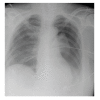Bilateral pneumothoraces following central venous cannulation
- PMID: 19901997
- PMCID: PMC2773426
- DOI: 10.1155/2009/745713
Bilateral pneumothoraces following central venous cannulation
Abstract
We report the occurrence of a bilateral pneumothoraces after unilateral central venous catheterization of the right subclavian vein in a 70-year-old patient. The patient had no history of pulmonary or pleural disease and no history of cardiothoracic surgery. Two days earlier, she had a median laparotomy under general and epidural anaesthesia. Prior to the procedure, the patient was hemodynamically stable and her transcutaneous oxygen saturation was 97% in room air. We punctured the right pleural space before cannulation of the right subclavian vein. After the procedure, the patient slowly became hemodynamically instable with respiratory distress. A chest radiograph revealed a complete left-side pneumothorax and a mild right-side pneumothorax. The right-side pneumothorax became under tension after left chest tube insertion. The symptoms finally resolved after insertion of a right chest tube. After a diagnostic work-up, we suspect a congenital "Buffalo chests" explaining bilateral pneumothoraces and a secondary tension pneumothorax.
Similar articles
-
Bilateral pneumothorax after pacemaker placement "Buffalo chest".Respir Med Case Rep. 2019 Jan 29;26:227-228. doi: 10.1016/j.rmcr.2019.01.022. eCollection 2019. Respir Med Case Rep. 2019. PMID: 30740301 Free PMC article.
-
Bilateral pneumothoraces following a right subclavian catheter insertion after thymectomy for a patient with a myasthenic crisis.Ochsner J. 2013 Summer;13(2):256-8. Ochsner J. 2013. PMID: 23789013 Free PMC article.
-
Bilateral pneumothoraces secondary to latrogenic buffalo chest. An unusual complication of median sternotomy and subclavian vein catheterization.Ann Surg. 1984 Mar;199(3):372-4. doi: 10.1097/00000658-198403000-00021. Ann Surg. 1984. PMID: 6703799 Free PMC article.
-
How to avoid and manage a pneumothorax.J Vasc Access. 2006 Jan-Mar;7(1):7-14. doi: 10.1177/112972980600700103. J Vasc Access. 2006. PMID: 16596523 Review.
-
[ST elevation and tension pneumothorax].Rev Esp Cardiol. 2000 Mar;53(3):467-70. doi: 10.1016/s0300-8932(00)75111-6. Rev Esp Cardiol. 2000. PMID: 10712976 Review. Spanish.
Cited by
-
Bilateral pneumothorax after pacemaker placement "Buffalo chest".Respir Med Case Rep. 2019 Jan 29;26:227-228. doi: 10.1016/j.rmcr.2019.01.022. eCollection 2019. Respir Med Case Rep. 2019. PMID: 30740301 Free PMC article.
-
Failure to meet extubation criteria in the setting of suspected buffalo chest physiology.Anaesth Rep. 2021 Feb 7;9(1):32-36. doi: 10.1002/anr3.12095. eCollection 2021 Jan-Jun. Anaesth Rep. 2021. PMID: 33604576 Free PMC article.
-
The Legend of the Buffalo Chest.Chest. 2021 Dec;160(6):2275-2282. doi: 10.1016/j.chest.2021.06.043. Epub 2021 Jun 30. Chest. 2021. PMID: 34216606 Free PMC article.
-
Simultaneous bilateral spontaneous pneumothorax with congenital pleuro-pleural communication.J Thorac Dis. 2013 Feb;5(1):87-9. doi: 10.3978/j.issn.2072-1439.2012.11.09. J Thorac Dis. 2013. PMID: 23372954 Free PMC article.
References
-
- Ruesch S, Walder B, Tramer MR. Complications of central venous catheters: internal jugular versus subclavian access. A systematic review. Critical Care Medicine. 2002;30(2):454–460. - PubMed
-
- Miura K, Tomiyasu S, Cho S, Sakai T, Sumikawa K. Pneumothorax associated with epidural anesthesia. Journal of Anesthesia. 2004;18(2):138–140. - PubMed
-
- Zaugg M, Stoehr S, Weder W, Zollinger A. Accidental pleural puncture by a thoracic epidural catheter. Anaesthesia. 1998;53(1):69–71. - PubMed
-
- Moore KL, Agur AM. Essential Clinical Anatomy. 3rd edition. Philadelphia, Pa, USA: Lippincott Williams and Wilkins; 2005.
-
- Parsons AM, Detterbeck FC. Of buffaloes, horseshoes, and having no connections. Annals of Thoracic Surgery. 2005;80(4):1521–1523. - PubMed
Publication types
LinkOut - more resources
Full Text Sources




